
Anyone who owns a dog knows that dogs love to run and play. Perhaps a geriatric dog would rather lounge in the sun and warm his aching bones, but most dogs want and need exercise. Walking on a leash with Master is seldom enough so, unless a dog park is nearby, a play yard is required. If planning a play yard, preventing dog escapes is a critical aspect to consider.
Why Your Dog Escapes
Most dogs are protective. Some are natural hunters. Therefore dogs will want to drive away perceived threats like other dogs, school bus monsters, delivery service trucks, and cars with loud exhaust systems. Some will chase prey: cats, squirrels, bunny rabbits, and birds. Others are gregarious and want to play with passers-by. Some have an adventurous spirit and occasionally get the wander-lust.
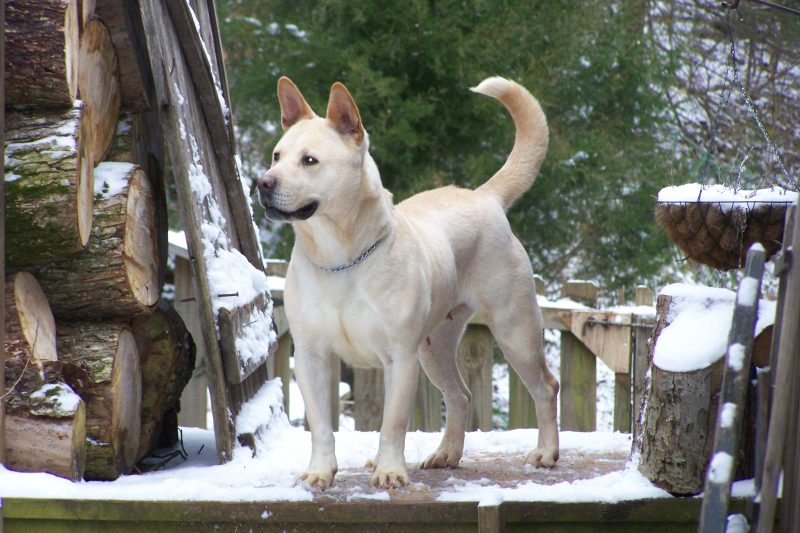 Our “Houdini dog”: Blondie Bear, fell into these last two categories. She likes to make friends, but also has (or had) a strong wander-lust. She’s a big girl: 90 pounds, but powerful and surprisingly agile for her size. She posed quite a challenge in preventing dog escapes, until I learned a few tricks. Tricks on preventing dog escapes that I will now share with you.
Our “Houdini dog”: Blondie Bear, fell into these last two categories. She likes to make friends, but also has (or had) a strong wander-lust. She’s a big girl: 90 pounds, but powerful and surprisingly agile for her size. She posed quite a challenge in preventing dog escapes, until I learned a few tricks. Tricks on preventing dog escapes that I will now share with you.
Chain-Tether-Run
Some dog owners opt for the simplicity of putting their dog on a chain or vinyl coated steel cable that is attached to something solid. As a permanent solution to dog escapes, this is a terrible idea. Many communities are passing ordinances making it illegal to tether a dog for more than a very short time (like an hour). No one wants to see a dog living his live on the end of a six foot chain staked to the ground. This is abuse and can result in criminal prosecution.
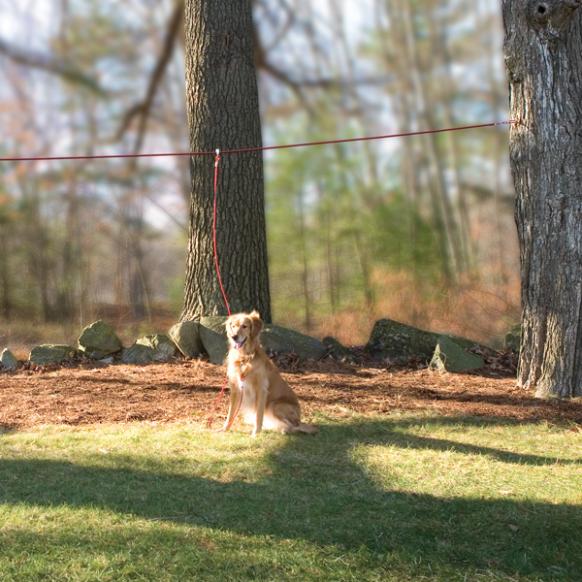 If no other solution is available, using a cable & trolley run to extend a dog’s range while keeping him secured is better than a simple tether, but still presents problems especially in the area of potential injury to the dog.
If no other solution is available, using a cable & trolley run to extend a dog’s range while keeping him secured is better than a simple tether, but still presents problems especially in the area of potential injury to the dog.
Walls
Stone, brick, or heavy timber walls are effective barriers to dog escapes as long as they are high enough they can’t be jumped over and smooth enough they can’t be scaled. These are usually built on a footer that will discourage tunneling out.
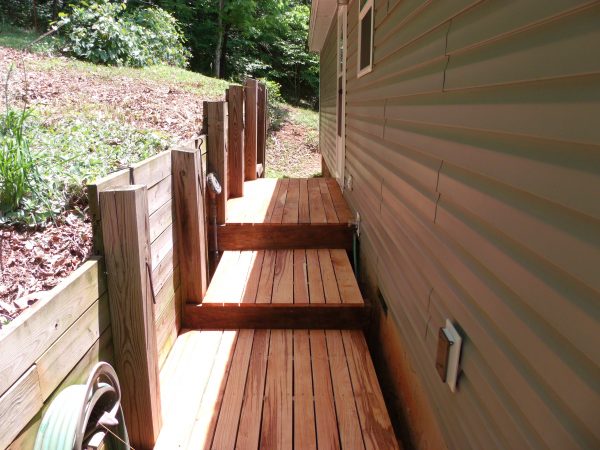 We have one wall (The Great Wall of Edwina) that, at 8 feet high, is tall enough Blondie cannot even hope to jump it, but when we built a back porch she could stand up, hook her fore paw claws over the top, use the hind claws to get purchase on the cracks between boards and boost herself up and over. I’d hear her scrabbling on the wood and get to the door just in time to see her big blonde hiney bouncing off into the woods. The other end was grinning, I’m sure!
We have one wall (The Great Wall of Edwina) that, at 8 feet high, is tall enough Blondie cannot even hope to jump it, but when we built a back porch she could stand up, hook her fore paw claws over the top, use the hind claws to get purchase on the cracks between boards and boost herself up and over. I’d hear her scrabbling on the wood and get to the door just in time to see her big blonde hiney bouncing off into the woods. The other end was grinning, I’m sure!
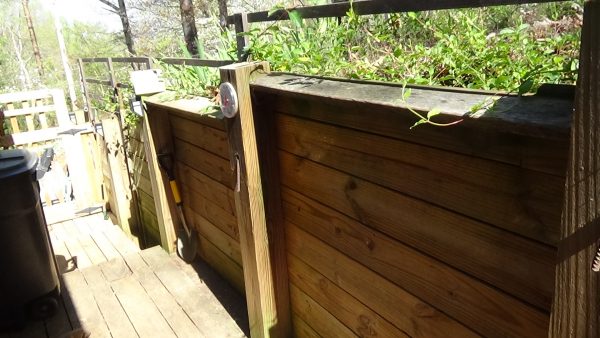 I fixed this by adding decorative rails to the top to make it harder (but not impossible) to climb over. I beefed that up by adding a shelf at the top of the wall, angled down a little so she could not hook her claws over it. This put a stop to that escape route. She was NOT amused!
I fixed this by adding decorative rails to the top to make it harder (but not impossible) to climb over. I beefed that up by adding a shelf at the top of the wall, angled down a little so she could not hook her claws over it. This put a stop to that escape route. She was NOT amused!
Hedges
There are some hedges: like Osage Orange, Box Hedge, Lonicera nitida, and Berberis that can – with LOTS of pre-planning time be made into a fairly effective barrier to some dog escapes. But that time factor is often an issue. And it will take LOTS of plants, planted close together and carefully nurtured to weave a solid enough barrier to contain the average dog.
Part of the reason these are effective is that most of these are thorny. But some dogs don’t have the sense to avoid painful situations if they stand in the way of something she wants – like chasing a cat. And, punctures and tears resulting from thorny plants often necessitate a trip t the vet because they abscess. In my mind, this is not the best solution to dog escapes
If the hedge is intended to be decorative as well as a barrier, erect a fence then plant a non-thorny hedge next to the fence and allow it to grow through the fence to hide it.
Fencing
Your primary deterrent to dog escapes will be fencing. Fencing comes in a plethora of forms and styles and can be tailored to fit into most any landscaping scheme or Home Owner’s Association requirements.
Electronic Fence
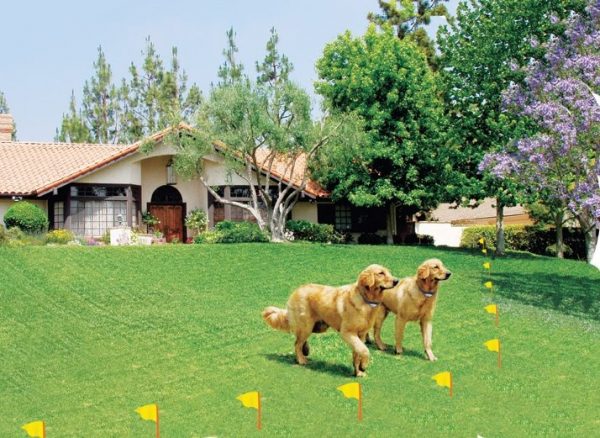 This is different from an electrified fence in that there is no visible, physical barrier and no other animal (or person) can be shocked by it. It works by burying an insulated wire that carries a signal just under the surface of the ground. That signal will trigger a shock collar worn by the dog. Some brands beep at the dog to warn or remind him that he’s crossed into the boundary zone. Small flags are placed inside the boundary zone during training to serve as a visual reminder to the dog. Some owners find this a good way to contain a sedate dog.
This is different from an electrified fence in that there is no visible, physical barrier and no other animal (or person) can be shocked by it. It works by burying an insulated wire that carries a signal just under the surface of the ground. That signal will trigger a shock collar worn by the dog. Some brands beep at the dog to warn or remind him that he’s crossed into the boundary zone. Small flags are placed inside the boundary zone during training to serve as a visual reminder to the dog. Some owners find this a good way to contain a sedate dog.
Dogs who will come charging across the yard like a freight train can blow right through the boundary zone, ignoring the beep and accepting the zap from the collar in their dogged pursuit. Worse, once she is out of the yard, the pursuit is ended, and she comes strolling back, the collar will prevent her from reentering the protected yard unless Master turns off the power.
Master will also need to be sure the collar has fresh batteries in it, weak or dead batteries remove all deterrent to dog escapes.
Physical Fencing
Fencing that provides a physical barrier works better for all but the most casual escape artist. This can be chain link, steel mesh, wrought iron, molded plastic, or wooden. There are also some brands of plastic mesh fencing that is designed to keep deer out of your yard, but this tends to be easily defeated by dogs and is not suitable for this purpose. I know: we’ve tried it. The material and style you choose is a matter of taste and economics … and your dog.
A small dog will be difficult to contain with most wooden fences because even small gaps along the bottom edge will be exploited. A jumper-climber will need a high fence, perhaps with augmentation at the top to keep him in. More on that in a while. Some dogs are efficient tunnelers and will dig under anything without a surface barrier or a substantial foundation.
Evaluate your dog’s behavior by watching her play (perhaps at a dog park) then determine what barrier will be best suited to her behavior and your wallet.
Masterful Fence Thwarts
For the sake of simplicity – and because this is the most common choice – I will base the rest of my dissertation (mostly) on chain-link fencing. These tips can be adapted to most other types of fencing, so if you’re considering something else, read on anyway.
Don’t skimp on height
My biggest regret concerning the installation or our chain link dog play yard fence is that I opted to save a few bucks and go with the 5 foot high fence and not the 6 foot fencing. For most of the foster dogs we’ve cared for the 5 foot has been perfectly adequate, but there have been a couple where I wished for the 6 foot.
Even our own Cochise got to where he’d come steaming down the hill and leap up on the fence at the lower end. He could jump up to where he could grab the top rail with his fore paws and hang there with head and chest above the fence, doing his best to force the UPS or FedEx personnel delivering to either of my nearest neighbors to soil themselves.
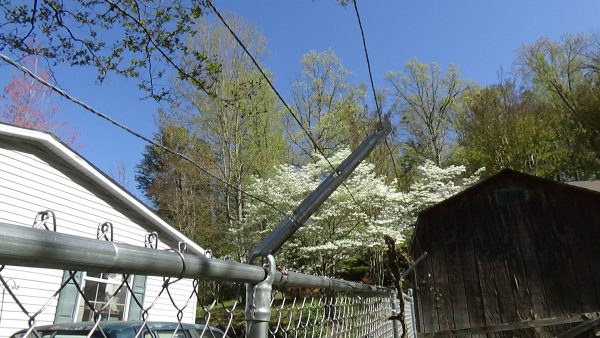 To prevent them from black-listing us all for delivery, I had to install barbed wire arms atop the fence around that low corner. I faced the arms inward rather than outward, because this was a deterrent to climbing out not in, and I used smooth cable rather than barbed wire to prevent injury to Cochise should he decide to test these measures against dog escapes.
To prevent them from black-listing us all for delivery, I had to install barbed wire arms atop the fence around that low corner. I faced the arms inward rather than outward, because this was a deterrent to climbing out not in, and I used smooth cable rather than barbed wire to prevent injury to Cochise should he decide to test these measures against dog escapes.
As it turned out, looking up and seeing the extra three wires netting inward was enough to keep him from doing a pull-up on the fence any more. That does not mean he no longer attempts to intimidate them, just that he does it from ground level now.
Don’t get gappy
The lower edge can be a problem too, especially on uneven terrain (like ours). A good fence installer will be able to mount the fence so it hugs most hills and hollers of your yard, but for those smaller dips or runnels, fill those in with large rock, then cover that with dirt and plant grass. Chunks of rock are harder for a dog to pull out while digging. Gravel is not a deterrent. Concrete is even better, but not good aesthetically.
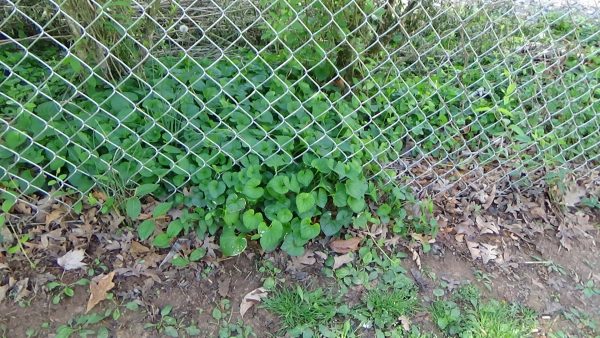 Hide small gaps under the fence that may tantalize your dog into digging by allowing dead leaves to pile up, or adding mulch, or plant mounding plants along the fence. This also helps keep grass from growing up into the fencing.
Hide small gaps under the fence that may tantalize your dog into digging by allowing dead leaves to pile up, or adding mulch, or plant mounding plants along the fence. This also helps keep grass from growing up into the fencing.
Some advocate digging a trench along your fence line, installing the fence an inch or two below ground level, then fill the trench with concrete so the lower edge of the fence is embedded in the concrete. This sounds like a fine idea, until that fencing needs replacing. At least in places. That task will be vastly complicated if it’s embedded in concrete.
If your furry friend still insists on digging toward dog escapes, you can lay rabbit fencing on the ground and poke the edge under the fence and pin it down with landscape staples. This will keep your dog from digging, allow grass to grow up through it, and stay down so you can mow over it. Do not use poultry mesh: it rusts way too fast laying on the ground and will turn into a rusty, splintery mess that is likely to lacerate your diggers paws.
Keep the tension on
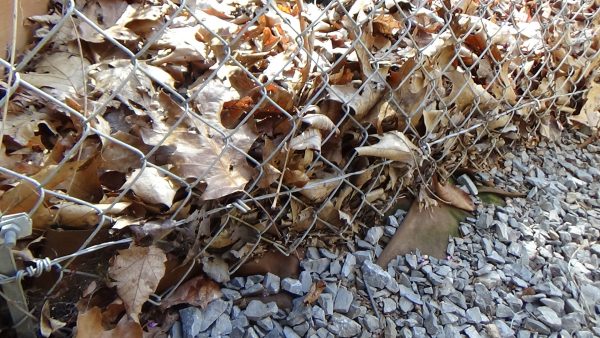 The lower edge of any wire fence needs to be able to prevent a dog from getting a nose under and pushing the fencing up. Wire mesh fencing can be staked down with landscape pins or tent pegs. Chain link works well with a heavy tension wire run between poles along the bottom and wound up tight. Fasten the fencing to the wire every foot or so with hog rings.
The lower edge of any wire fence needs to be able to prevent a dog from getting a nose under and pushing the fencing up. Wire mesh fencing can be staked down with landscape pins or tent pegs. Chain link works well with a heavy tension wire run between poles along the bottom and wound up tight. Fasten the fencing to the wire every foot or so with hog rings.
Note that wire mesh fencing is NOT good on hilly terrain because it does not flex like chain link does. It is an economical option for nice flat lots.
No climbing allowed
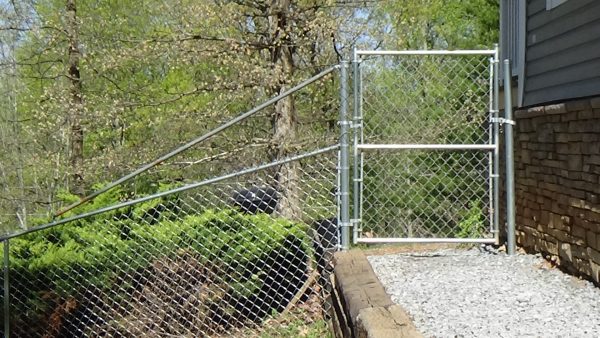 Prevent dog escapes by being sure you have not left anything near enough a fence that she can use it to climb on and get over. Dog house, trash cans, chairs, storage box, or a brush pile can all provide a boost up: keep them well away from the fence. We had a situation where a retaining wall ran up to the fence and effectively reduced the fence height to where our Houdini dog could clamber over it. I had to add another top rail and some steel mesh to thwart dog escapes via that route.
Prevent dog escapes by being sure you have not left anything near enough a fence that she can use it to climb on and get over. Dog house, trash cans, chairs, storage box, or a brush pile can all provide a boost up: keep them well away from the fence. We had a situation where a retaining wall ran up to the fence and effectively reduced the fence height to where our Houdini dog could clamber over it. I had to add another top rail and some steel mesh to thwart dog escapes via that route.
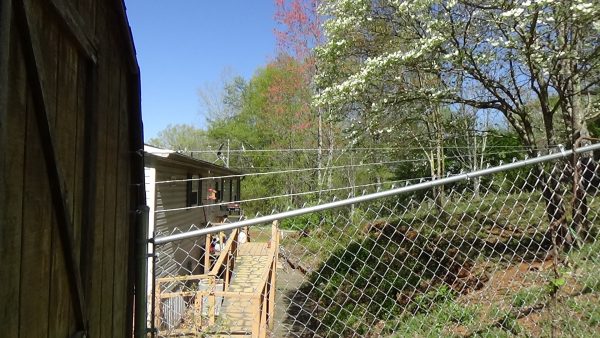 Similarly, the ramp up into our storage barn provided just enough boost to tempt her to go over the fence where it met the barn, so I added top cables (without arms this time) to discourage that.
Similarly, the ramp up into our storage barn provided just enough boost to tempt her to go over the fence where it met the barn, so I added top cables (without arms this time) to discourage that.
For determined climbers, anti-coyote rollers can be mounted along the fence top. They are as effective at keeping a dog in as they are at keeping coyotes out.
Gates of Opportunity
Gates provide another series of challenges to preventing dog escapes.
Traffic through a gate often wears down the grass at that point. As the grass dies off, the soil erodes. As the soil goes away, gaps open up under the gate that tempt a digger to try tunneling out. To thwart that, sink a landscape timber in the ground directly under the gate. That will prevent digging and will help retain soil that’s trying to wash away.
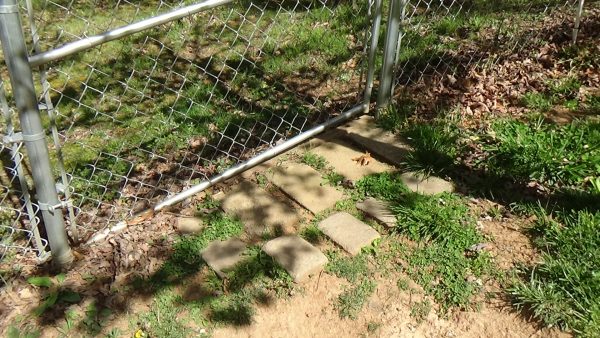 To further this thought, sink pavers into the dirt inside the gate to form a small patio. This will further prevent digging, discourage erosion, and make a nice warm spot for the felonious fido to lay on while figuring out how to defeat the gate latch.
To further this thought, sink pavers into the dirt inside the gate to form a small patio. This will further prevent digging, discourage erosion, and make a nice warm spot for the felonious fido to lay on while figuring out how to defeat the gate latch.
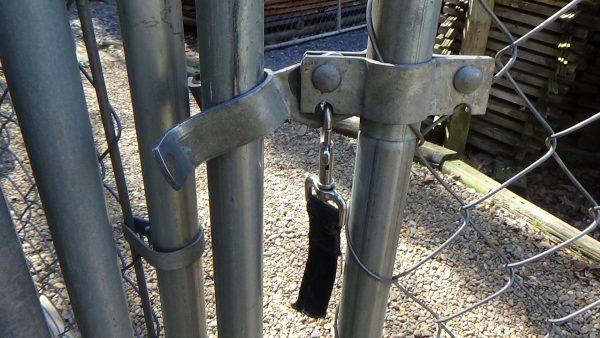 Speaking of which, use a piston hook or brooding hook (or a padlock) to secure the latch so that a clever dog (Border Collies and Huskies are adept at this) from pushing the gate latch up with their nose and sprinting off into freedom.
Speaking of which, use a piston hook or brooding hook (or a padlock) to secure the latch so that a clever dog (Border Collies and Huskies are adept at this) from pushing the gate latch up with their nose and sprinting off into freedom.
I’m not kidding about the padlocks. We have 5 gates into our play yard. One I pass through multiple times daily as I move about our property and care for the dogs. On that gate I use a piston hook on a strap. I WD40 it often so it doesn’t rust or ice up in winter. For the other gates I got a set of 4 padlocks that are keyed alike so one key opens them all. Not only is this guaranteed to keep the dogs from defeating the latch – unless the dog yanks on the gate so hard he bends the latch enough to spring the gate, which actually happened once: a pit bull of course! I had to install double latches on his favorite gate while he was here – but it insures that some neighborhood kid, prankster, or determined salesman doesn’t make an unauthorized entry and accidentally (or purposefully) leave the gate open.
Mind Games
We had one foster who was an acrobat dog: he could easily scramble over our 5 foot fencing. Even our 6 foot pens barely slowed him down until I hung mesh inside the tarpaulin roof to prevent him from squeezing out between the bungies that held the tarp to the roof rails. The shelter he came from said he scaled their 8 foot high walls with little trouble! How was I going to keep him in our yard!?
Psych him out
I started by keeping him on a 20’ nylon lead and running along behind him (as best I could) so I could pull him back if he headed too close to a fence. He got accustomed to the idea that I would pull him off course every time he approached the fencing, and eventually gave up trying.
After a while I could clip the lead on him and let go of it so he could run around without dragging me around on the other end – but he didn’t make the connection that I wasn’t able to stop him now. I was still in the yard with him, just not attached. As long as he had a lead clipped to his collar he felt “grounded” and made no attempt at the fence. It sounds silly, but it worked like a charm.
Visual impairment
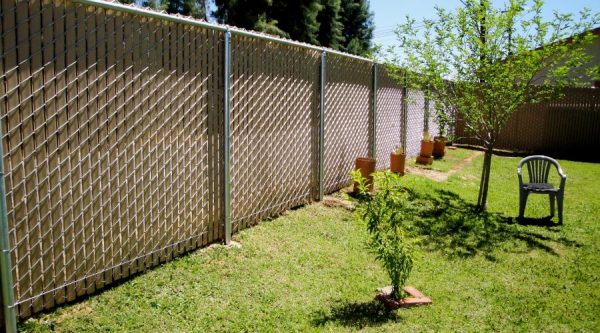 Another way to reduce the desire to vault a fence is to impair the dog’s view of what lies outside the yard. A board fence is great for this, but even a chain link fence can be fitted with slats that slide into the links. They are available in a variety of colors and do a pretty good job of adding privacy to a chain link fence. This won’t diminish a dog’s sense of hearing or smell, but it may stop them from going bonkers every time a squirrel saunters across the neighbor’s yard.
Another way to reduce the desire to vault a fence is to impair the dog’s view of what lies outside the yard. A board fence is great for this, but even a chain link fence can be fitted with slats that slide into the links. They are available in a variety of colors and do a pretty good job of adding privacy to a chain link fence. This won’t diminish a dog’s sense of hearing or smell, but it may stop them from going bonkers every time a squirrel saunters across the neighbor’s yard.
~ * ~ * ~ * ~
There you have it: my list of ways to prevent dog escapes – have you any other suggestions? Please share them in the comments below, doing so is painless and free. Thanks for reading!
| If you enjoy our updates, Doggy Tales, and educational articles consider subscribing for notices when new pieces are posted. It’s painless and you can unsubscribe any time you want. Your e-mail address is used ONLY to deliver these notices. | [email-subscribers namefield=”YES” desc=”” group=”Public”] |



